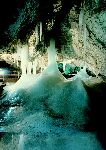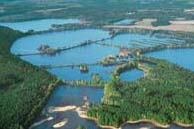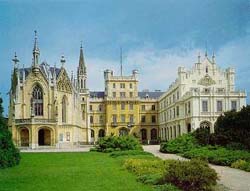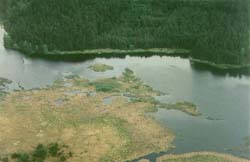DAY 1: 
We fly to Vienna, meet our minibus and guide and transfer to
Central Slovakia. Dinner and overnight in 2* Hotel Bobrovnik.
(This hotel is ideally situated among the Chocske Hills,
West Tatras and Low Tatras.)
DAY 2:
Bird watching in the Chocske Hills with local expert Mr. Bohumil Murin.
Chocske Hills - a limestone range (max. 1611 metres
Mt Velky Choc), one of the few places in central Slovakia not yet discovered by tourists.
We expect to see several pearls of European birds here.
In the Prosiecka Valley, in the conifer forest, we
will find Nutcracker and Peregrine Falcon. We also expect to see Eagle Owl, Golden Eagle
and Wallcreeper. Our next targets will be Hazelhen, Pygmy and Tengmalms Owl, Black,
Three-Toed and White-Backed Woodpeckers, Dipper etc. All these birds are relatively common
in this small area.
Near Liptovska Mara reservoir, we will admire several
singing Scarlet Rosefinches and try to find noisy Corn Crake. On the water surface of the
reservoir we will see various ducks and hopefully Divers.
DAY 3:
We spend the day in High Tatras National Park, a beautiful mountain range at 2655
metres (the highest in Slovakia). We will also visit Strbske Pleso (lake) and enjoy an
easy walk among two ranges up to Popradske Lake trying to see Golden Eagle, Chamoises and
Marmots and beautiful alpine flowers. From Popradske Lake we will enjoy a beautiful view
of central Slovakia beneath us.
DAY 4: 
In Low Tatras National Park, we will take a chair lift to Mt. Chopok
(2002 metres) and then enjoy an easy walk along the main range,
enjoying Alpine Accentors, Ring Ouzels, Lesser Spotted Eagle and
various alpine flowers
During the afternoon we will visit world famous
Demanovska Cave
and World Heritage Site, Vlkolinec village, one of the best preserved
old style villages in the country. In the village we can see Wryneck,
Garden Redstart, Black Stork and other species.
DAY 5:
We will continue to the town of Levoca for a marvelous lunch at the "Restaurant
of the Three Apostles" and a visit in this medieval town, made famous by its
Cathedral which has the largest carved wooden altarpiece in the world.
We will stop at Slovak Carst, (limestone mountains),
where we will try to observe Rock Buntings, Rock Thursh and limestone like flowers. Later
in the afternoon we will arrive in East Slovakia for four overnights in a good 2* hotel
situated near Zemplinska Sirava reservoir, only 20 km from the Ukrainian Border. During
the transfer we will admire many White Stork nests (these are in nearly every village).
From the minibus we will also see flying Lesser Spotted Eagle.
DAY 6: 
We will spend the day exploring the Eastern Carpathian National Park and the
Biospherical Reserve, in the SE corner of Slovakia near the border with Poland and
Ukraine. We will walk through huge beech forests with Ural Owl, White Backed Woodpecker,
Hazel Hen, Lesser Spotted and Golden Eagles, Collared and Red-Breasted Flycatchers. In
Carpathian Meadows we hope to see Corncrake and Black Stork in addition to many plants. We
will also visit a Russian Orthodox, wooden church dating from the 17th century. In the
evening, near the Cirocha River, we will have a chance to distinguish Nightingale and
Thrush Nightingale from their singing.
DAY 7 and 8:
For these two days we will be accompanied by well-known Slovak ornithologist Dr.
Stefan Danko. This bird paradise, lying on the border between Hungary and Ukraine, will
offer us two exciting days and about 120 bird species.
We will visit the following:
1. Senne Ponds (Ramsar Site), a complex of 25 fish
ponds and 1 bird reserve, with varying water levels offering ideal habitat for around 100
bird species including Great- white Egret, Purple Heron, Pygmy Cormorant, Spoonbill,
Short-eared Owl, Penduline Tit, waders and warblers.
2. The Vihorlat Hills and surrounding area. We will
see protected nest of Imperial Eagle. Dr. Danko will inform us about his project
"Nest Protection of Imperial Eagles in Slovakia". We have a very good chance to
see other raptors, such as Short-toed Eagle, Booted Eagle, Saker and Red-footed Falcon. In
addition to raptors we will enjoy Eagle Owl, Short-toed Lark, Beeater, and Lesser Grey
Shrike.
3. Near the Tarbucka Hills we will try to find
Hoopoe, Syrian Woodpecker, and Icterine Warbler. Here we will also have an opportunity to
taste the local TOKAI wines.
We will spend the evening searching for Scops Owls
and Nightjars near Dr. Danko's house.
DAY 9:
We will drive via the marshes of the Bodrog River (migrating waders) to the
Bratislava area to observe Great Bustards. We will finish our day at Valtice where we will
spend three nights in a nice Baroque chateau.
DAY 10-11: 
We will spend these two days in a World Heritage UNESCO
area: the Lednice-Valtice Complex.
The Lednice-Valtice complex is a European rarity
situated near
the Austrian border. It consists of 7 castles, two huge parks,
two historical towns and several pilgrimage churches. This
entire area was formerly owned by the Lichteinstein and
Dietrichstein families.
Valtice castle, the counterpart of the
Lichteinstein's Lednice
residence, has the appearance of an older chateau but was rebuilt under the direction
of J. B. Fisher of Erlach. Valtice Park was founded in 1727, and consists of a garden and
"English park", linked by a wide avenue. We will enjoy the famous mythological
sculptures, the artificial cave called "The Hell' and the rich collections of trees.
We will have lunch in Valtice.
Lednice castle, originally a Gothic castle which was
modified and expanded into a Renaissance chateau, was further modified in 1760 by J. B.
Fischer from Erlach into a Baroque structure. The current Tudor Gothic appearance is the
outcome of reconstruction between 1846 and 1858. You can see the Romantic interiors with
period furniture.
Lednice Park consists of the Baroque Garden and the largest "English park"
in the Czech Republic (270 ha). The Baroque garden was designed by Comino Martini, the
"English park" by architect Franti. The botanist for the project, Van der Scott
brought 36,000 exotic plants into Lednice. The Park is well known for its vistas, its
romantic follies and interesting plant species. The most important among the park
buildings are the artificial castle ruin, the Januv Hrad, the Turkish Minaret and the maur
Watertower. Next to the castle, there is an orangerie built by English architect Devien in
1843.
This entire complex is one of the most important bird reserves and is known for many
water birds (Storks, Night Herons etc). The Park extends into a large pine forest, an
excellent hunting place. This is also the site of the Czech College of Landscape
Architecture.
DAY 10:
We will visit Lednice Castle and Park to see Black and Syrian Woodpeckers and a
colony of Night Herons. We will have a picnic in the park. We will continue to bird watch
in Lednicke Rybniky Ponds and at the confluence of the Jihlava and Svratka rivers. A
system of five large fishponds, three large reservoirs and two rivers is an important bird
locality and is protected by Ramsar Convention. We hope to see Little and Great Bitterns,
White-tailed Eagle, Red and Black Kites, Saker, Black and Syrian Woodpeckers, Hoopoe, and
Penduline Tit. In the evening we will go to the Turold quarry to see Eagle Owl.
DAY 11: 
We will visit the flood plain at the confluence of the Morava and Dyje Rivers.
Riverine forests, of Quercus and Fraxinus, cover the majority of this area. Trees
of Salix, Carpinus and Populus are also important components of these
forests. This area contains numerous marshes, smaller streams, false and live channels.
The canals built on both rivers have stopped the regular spring inundation. Clear-cutting
and the intensive breeding of hoofed game have caused extensive damage to the vegetation.
Nowadays, forest managers, in cooperation with the Institute of Nature Conservancy, have
worked out a project to create artificial spring floods. This place is also an important
breeding area for various bird species such as Grey Heron, Black Stork, White Stork, Red
Kite, Imperial and White Tailed Eagles, Syrian Woodpecker, Icterine and River Warbler.
Pa1ava Biospherical Reserve
This is in South Moravia, close to the Austrian border. It is a remnant of the
biggest Moravian clippen rock (limestone). The Pavlovske Vrchy Hills, with the ruined
castle Devicky, is the most beautiful monument in the landscape. This area is especially
interesting for its thermophilic flora and fauna. We will enjoy here woodpeckers, kites,
warblers and other species. After this easy walking trip we will visit the historic town
of Mikulov for dinner, wine tasting in the wine cellar built inside the large limestone
cave, folk music and dancing.
DAY 12:
After breakfast, we transfer to the Vienna airport for our flight home. If there is
time we will walk through Vienna centre. |